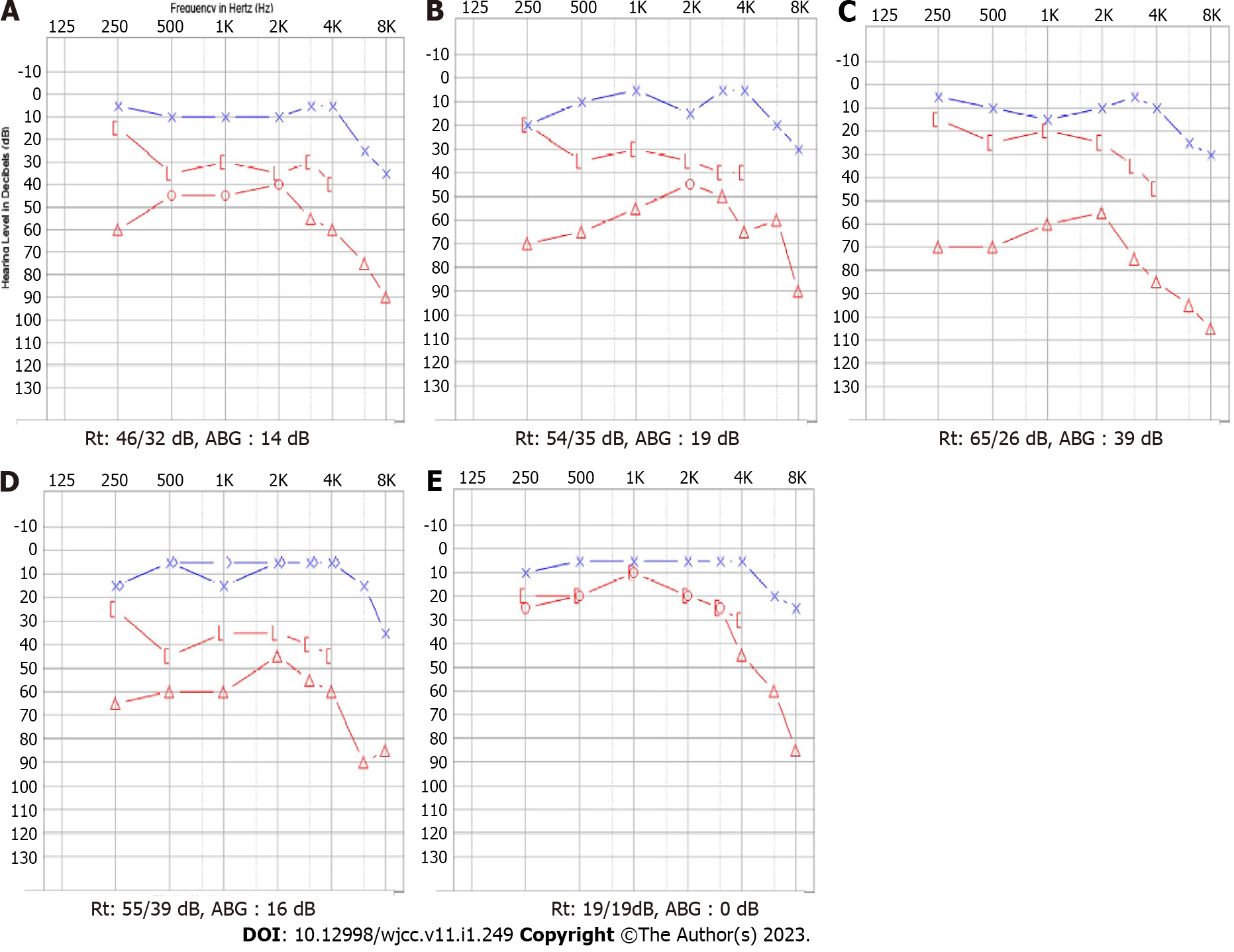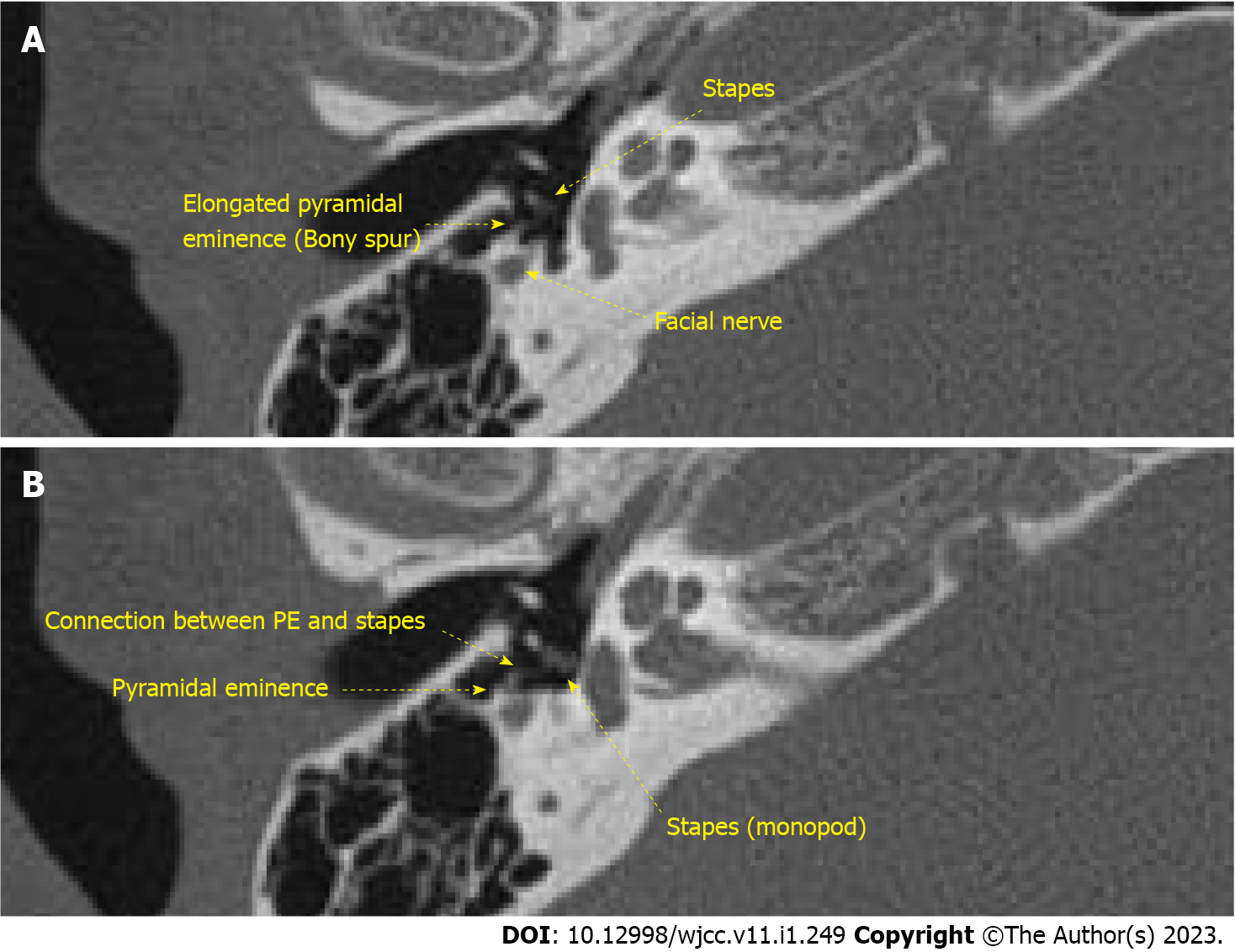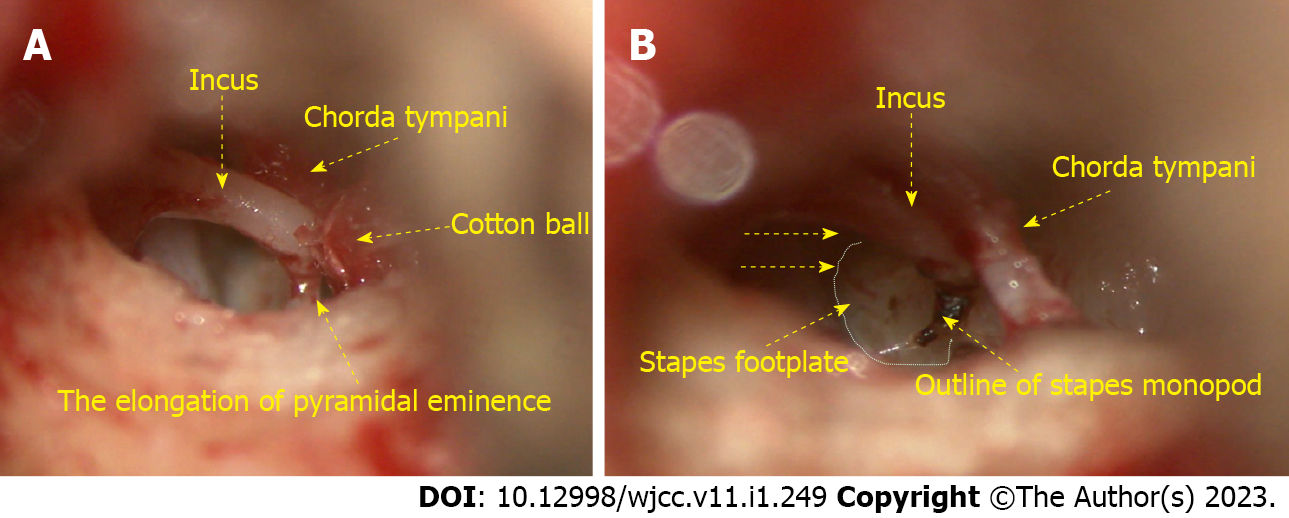Published online Jan 6, 2023. doi: 10.12998/wjcc.v11.i1.249
Peer-review started: November 2, 2022
First decision: November 22, 2022
Revised: November 30, 2022
Accepted: December 21, 2022
Article in press: December 21, 2022
Published online: January 6, 2023
Stapes ankylosis is a rare cause of conductive hearing loss, and stapes supra
Herein, we report a case of a 37-year-old female with an isolated stapedial supra
This is the first report of stapedial suprastructure fixation with fluctuating auditory symptoms. Successful results are expected with surgical treatment.
Core Tip: Stapes ankylosis is rare disease presenting with non-progressive conductive hearing loss that usually begins in the early years of life. However, as noted in our case, the patient might present with fluctuating auditory symptoms, such as tinnitus, ear fullness and alternating mixed hearing loss. When a persistent air bone gap is noted in audiometry, the possibility of middle ear anomaly should be suspected and successful results can be obtained with surgical treatment.
- Citation: Choi S, Park SH, Kim JS, Chang J. Congenital stapes suprastructure fixation presenting with fluctuating auditory symptoms: A case report. World J Clin Cases 2023; 11(1): 249-254
- URL: https://www.wjgnet.com/2307-8960/full/v11/i1/249.htm
- DOI: https://dx.doi.org/10.12998/wjcc.v11.i1.249
Stapes ankylosis is a rare cause of conductive hearing loss, which prevents sound transmission to the inner ear as a result of a stapes ossification. Isolated stapes ankylosis is broadly divided into two categories: Footplate fixation and suprastructure fixation[1,2]. Footplate fixation is relatively commonly encountered and mostly caused by otosclerosis, tympanic sclerosis, and congenital stapes fixation. However, suprastructure fixation is rare, and fewer than 30 cases have been reported since 1957. The fixation focus is mentioned as elongation of pyramidal eminence, stapedial tendon ossification or adhesion to the promontory[3-7]. Patients generally visit the clinic with non-progressive conductive hearing loss that usually began in the early years.
Herein, we report a patient with fluctuating auditory symptoms of tinnitus, ear fullness and mixed hearing loss who was diagnosed as isolated stapedial suprastructure fixation with monopod stapes caused by elongated pyramidal eminence. This study was approved by the Institutional Review Board of the authors’ institute (2022-08-007). To our knowledge, this is the first report of stapedial suprastructure fixation with fluctuating auditory symptoms.
Fluctuating hearing loss, tinnitus, earfullness and dizziness.
A 37-year-old female patient visited the outpatient clinic with a hearing disturbance in the right ear for 20 years. She complained of accompanying tinnitus and ear fullness, which would wax and wane and abruptly worsen over time. She also mentioned alternating lightheadedness.
There was no history of otitis media, trauma or otologic surgery.
She had no family history of hearing loss.
Endoscopic examination revealed a normal-appearing external auditory canal, and tympanic membrane.
Laboratory test results were within the normal ranges.
A pure-tone audiogram showed moderate mixed hearing loss on the right ear [bond conduction (BC) 32 dB hearing level (HL), air conduction (AC) 46 dB HL] with an air-bone gap (ABG) of 14 dB, whereas the left ear showed a normal HL (Figure 1A). On frenzel examinations there was no spontaneous nystagmus but there was a right-beating nystagmus after the head shaking test. There were no specific findings in the positional test and video head impulse test; however, in the electrocochleography, the summating potential (SP)/action potential (AP) ratio was elevated to 0.421 on the right side (left side 0.188). A follow-up pure-tone audiogram after 2 mo showed moderate mixed hearing loss on the right (BC 35 dB HL, AC 54 dB HL) with an ABG of 19 dB, with AC threshold elevated in low frequencies (Figure 1B).
She revisited the outpatient clinic after 2.5 years of follow-up loss. She complained of frequent tinnitus on the right side and lightheadedness following head movement. A pure-tone audiogram showed moderate to severe mixed hearing loss on the right (BC 26 dB HL, AC 65 dB HL) with an ABG of 39 dB, which seemed to have been aggravated compared to 2.5 years before with increased ABG (Figure 1C).
A detailed examination based on temporal bone computed tomography (CT) showed an elongated pyramidal eminence over the facial nerve (Figure 2A), a connection between pyramidal eminence and stapes, and a thickened stapes, which was identified as a monopod crura at the operation (Figure 2B).
The patient was diagnosed with isolated stapedial suprastructure fixation with monopod stapes caused by elongated pyramidal eminence.
We decided to perform the exploratory tympanotomy. A pure-tone audiogram conducted one day before the surgery showed moderate mixed hearing loss on the right (BC 39 dB HL, AC 55 dB HL) with an ABG of 16 dB which demonstrated the fluctuating audiologic character of the patient (Figure 1D). An endaural approach was performed, and tympanomeatal flap was elevated to expose the chorda tympani and the neck of malleus. The posterior tympanic spine was removed with a curette and drilling, and the ossicular chain was examined. The mobility of the ossicular chain was fixed initially. However, after separation of the incus-stapes joint, the malleus-incus complex moved freely while the stapes and footplate were tightly fixed. Elongation of pyramidal eminence was noted, and it was connected to the stapes head (Figure 3A). The stapes crura was thickened by the fusion of anterior and posterior crura creating a monopod shape (Figure 3B). The bony connection between the pyramidal eminence and stapes suprastructure was removed by CO2 laser. After the procedure, the stapes became mobile, and the footplate showed normal mobility with a normal round window reflex. The incus and stapes were reconnected with surgical glue, the middle ear was packed with gelfoam, and the tympanomeatal flap was repositioned to its own position.
The bone conduction threshold of the right side at the post operative day 1 decreased to 14 dB, and the pure-tone audiogram conducted 1 mo after the surgery showed a normal HL (BC 19 dB HL, AC 19 dB HL) with no ABG (Figure 1E). Additionally, fluctuating tinnitus and ear fullness disappeared after the surgery.
Conductive hearing loss is rarely caused by congenital middle ear malformation with a reported incidence of 0.5%-3% in patients undergoing surgery for conductive hearing loss[8,9]. The most widely accepted classification of middle ear minor anomalies was suggested by Teunissen and Cremers which divides middle ear minor anomalies into four categories. Although various types of isolated congenital stapes ankylosis have been reported, stapes suprasturcture fixation is extremely rare[2,3]. The present case demonstrated isolated congenital stapes ankylosis with stapes suprastructure fixation caused by elongated pyramidal eminence.
There are few reports mentioning an elongated pyramidal eminence as the focus of stapes ankylosis. An elongated pyramidal eminence is also referred to as the ossification of the stapedial tendon or stapes pyramidal bony bar[4,5]. A previous study reviewed 22 cases of congenital middle ear minor malformation caused by stapes suprastructure fixation and subdivided the cases into the elongation of pyramidal eminence group, stapes-facial canal fixation group, and stapes-promontory fixation group[2]. Elongation of the pyramidal eminence or ossification of the stapedial tendon could occur due to an acquired reason, such as infection or inflammation, but could also be caused by congenital, autosomal-dominant or autosomal-recessive inheritance[10-12]. However, most previous reports have shown conductive hearing loss without past trauma or otitis media history, and the patients did not complain of any symptoms other than hearing discomfort. Our patient presented with fluctuating auditory symptoms, which is a unique symptom.
The patient in our case presented with fluctuating hearing loss, tinnitus and ear fullness which could have been mistaken as Meniere’s disease. Although the patient had a longstanding hearing disturbance in the right ear, the pure tone hearing threshold was altered at every follow-up test, and she complained of accompanying tinnitus and ear fullness, which would wax and wane. Additionally, her light
Fluctuating auditory symptoms are not common manifestations of congenital stapes ankylosis. The reason for the fluctuating auditory symptoms in our patient is unclear, but it is possible that the external sound stimulus or pressure changes might have affected endolymphatic dynamics by allowing sound transmission through the round window membrane but precluding the spread of sound waves through the oval window due to the fixed footplate. Another possible reason for fluctuating auditory symptoms is a potential progression in the stapedial tendon ossification by an unnoticed infection, inflammation or hormonal change[13]. Once middle ear malformation is clinically suspected, it can be diagnosed by temporal bone CT and exploratory tympanotomy. In most cases, hearing improvement is achievable by division of the stapedial tendon in the surgery[5,6].
Stapes suprastructure fixation by elongated pyramidal eminence is a very rare disease and presents with conductive hearing loss. However, as noted in our case, the patient might present with fluctuating auditory symptoms. When a persistent ABG is noted in audiometry, one must evaluate the middle with temporal bone CT and explorative tympanotomy, and successful results are expected with surgical treatment.
Provenance and peer review: Unsolicited article; Externally peer reviewed.
Peer-review model: Single blind
Specialty type: Medicine, research and experimental
Country/Territory of origin: South Korea
Peer-review report’s scientific quality classification
Grade A (Excellent): A
Grade B (Very good): B, B
Grade C (Good): 0
Grade D (Fair): 0
Grade E (Poor): 0
P-Reviewer: liu S, China; Shirini K, Iran; Wang P, China S-Editor: Wang JJ L-Editor: A P-Editor: Wang JJ
| 1. | Cremers CW, Teunissen E. The impact of a syndromal diagnosis on surgery for congenital minor ear anomalies. Int J Pediatr Otorhinolaryngol. 1991;22:59-74. [PubMed] [DOI] [Cited in This Article: ] [Cited by in Crossref: 23] [Cited by in F6Publishing: 23] [Article Influence: 0.7] [Reference Citation Analysis (0)] |
| 2. | Nandapalan V, Tos M. Isolated congenital stapes suprastructure fixation. J Laryngol Otol. 1999;113:798-802. [PubMed] [DOI] [Cited in This Article: ] [Cited by in Crossref: 15] [Cited by in F6Publishing: 15] [Article Influence: 0.6] [Reference Citation Analysis (0)] |
| 3. | Nandapalan V, Tos M. Isolated congenital stapes ankylosis: an embryologic survey and literature review. Am J Otol. 2000;21:71-80. [PubMed] [Cited in This Article: ] |
| 4. | Cremers CW, Hoogland GA. Congenital stapes ankylosis by elongation of the pyramidal eminence. Communication. Ann Otol Rhinol Laryngol. 1986;95:167-168. [PubMed] [DOI] [Cited in This Article: ] [Cited by in Crossref: 14] [Cited by in F6Publishing: 14] [Article Influence: 0.4] [Reference Citation Analysis (0)] |
| 5. | Kinsella JB, Kerr AG. Familial stapes superstructure fixation. J Laryngol Otol. 1993;107:36-38. [PubMed] [DOI] [Cited in This Article: ] [Cited by in Crossref: 15] [Cited by in F6Publishing: 15] [Article Influence: 0.5] [Reference Citation Analysis (0)] |
| 6. | Yoo JS, Lee CM, Yang YN, Lee EJ. Complete restoration of congenital conductive hearing loss by staged surgery: A case report. World J Clin Cases. 2021;9:10286-10292. [PubMed] [DOI] [Cited in This Article: ] [Cited by in CrossRef: 1] [Cited by in F6Publishing: 1] [Article Influence: 0.3] [Reference Citation Analysis (0)] |
| 7. | Lee JM, Lee HJ, Kim SH. A Case of Isolated Congenital Stapedial Suprastructure Fixation. Case Rep Otolaryngol. 2022;2022:8620738. [PubMed] [DOI] [Cited in This Article: ] [Reference Citation Analysis (0)] |
| 8. | Stewart JM, Downs MP. Congenital conductive hearing loss: the need for early identification and intervention. Pediatrics. 1993;91:355-359. [PubMed] [Cited in This Article: ] |
| 9. | Kisilevsky VE, Bailie NA, Dutt SN, Halik JJ. Hearing results of stapedotomy and malleo-vestibulopexy in congenital hearing loss. Int J Pediatr Otorhinolaryngol. 2009;73:1712-1717. [PubMed] [DOI] [Cited in This Article: ] [Cited by in Crossref: 15] [Cited by in F6Publishing: 15] [Article Influence: 1.0] [Reference Citation Analysis (0)] |
| 10. | Wetmore SJ, Gross AF. Congenital fixation of the head of the stapes in three family members. Ear Nose Throat J. 2011;90:360-366. [PubMed] [DOI] [Cited in This Article: ] [Cited by in Crossref: 5] [Cited by in F6Publishing: 5] [Article Influence: 0.4] [Reference Citation Analysis (0)] |
| 11. | Doi T, Nakazawa H, Adachi M, Kaneko T, Munemoto Y, Komeda M, Ikeda H, Kitajiri M, Yamashita T. Familial isolated stapes-pyramidal fixation by a bony bar with normal stapedius tendon. Arch Otolaryngol Head Neck Surg. 2005;131:349-352. [PubMed] [DOI] [Cited in This Article: ] [Cited by in Crossref: 6] [Cited by in F6Publishing: 6] [Article Influence: 0.3] [Reference Citation Analysis (0)] |
| 12. | Thies C, Handrock M, Sperling K, Rcis A. Possible autosomal recessive inheritance of progressive hearing loss with stapes fixation. J Med Genet. 1996;33:597-599. [PubMed] [DOI] [Cited in This Article: ] [Cited by in Crossref: 7] [Cited by in F6Publishing: 7] [Article Influence: 0.3] [Reference Citation Analysis (0)] |
| 13. | Ricci G, Gambacorta V, Lapenna R, Della Volpe A, La Mantia I, Ralli M, Di Stadio A. The effect of female hormone in otosclerosis. A comparative study and speculation about their effect on the ossicular chain based on the clinical results. Eur Arch Otorhinolaryngol. 2022;279:4831-4838. [PubMed] [DOI] [Cited in This Article: ] [Cited by in Crossref: 1] [Cited by in F6Publishing: 1] [Article Influence: 0.5] [Reference Citation Analysis (0)] |











